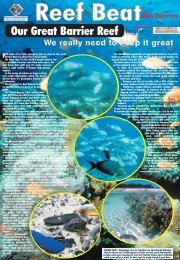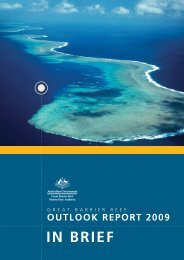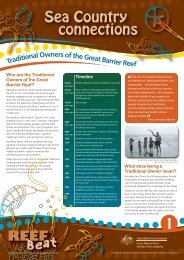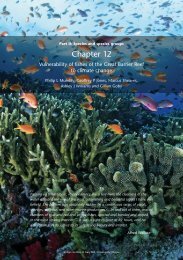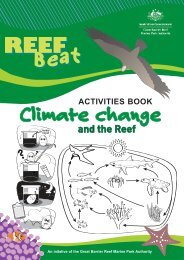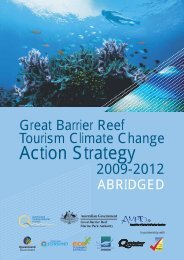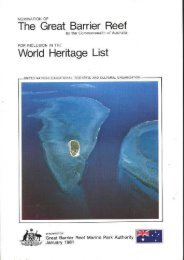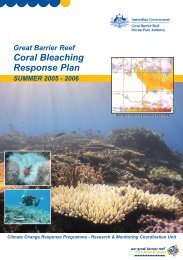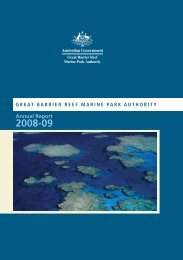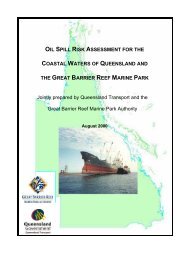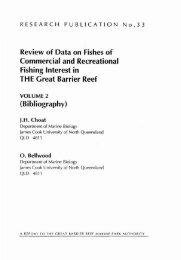2005 Reef Beat posters 1-8 in Cairns Post.pdf - Great Barrier Reef ...
2005 Reef Beat posters 1-8 in Cairns Post.pdf - Great Barrier Reef ...
2005 Reef Beat posters 1-8 in Cairns Post.pdf - Great Barrier Reef ...
- No tags were found...
You also want an ePaper? Increase the reach of your titles
YUMPU automatically turns print PDFs into web optimized ePapers that Google loves.
8Wetlands- an oasis of lifereef beatriver to reefWetlands arepeaceful placesof great beauty.WETLANDS are amaz<strong>in</strong>gand complex waterwaysthat occur <strong>in</strong> manydifferent sizes and forms.Wetlands are land areas eithertemporarily or permanently coveredby water. Types of wetlands <strong>in</strong>cludeswamps, marshes, billabongs,saltmarshes, mudflats, coral reefs,mangroves, lakes and peatlands.Mar<strong>in</strong>e habitats like coral reefs,seagrass meadows, mudflats,mangrove estuaries, samphire saltmarshes, rocky mar<strong>in</strong>e shores andsand or pebble beachesare common forms ofmar<strong>in</strong>e wetlands found<strong>in</strong> and around the <strong>Great</strong><strong>Barrier</strong> <strong>Reef</strong>.Wetlands are oftenareas of great beautywhere people enjoythe scenery and gatherfor recreation.In all their forms, wetlands arevery special places.THE IMPORTANCE OF WETLANDSWetlands <strong>in</strong> catchments alongthe coast next to the <strong>Great</strong> <strong>Barrier</strong><strong>Reef</strong> Mar<strong>in</strong>e Park are vital for thelong-term protection of the <strong>Great</strong><strong>Barrier</strong> <strong>Reef</strong>.Wetlands support a diverserange of mar<strong>in</strong>e life and providehabitat, breed<strong>in</strong>g and nurseryareas for birds, mammals, reptiles,amphibians, <strong>in</strong>sects and many fishspecies such as barramundi andmangrove jack.Wetlands play an important role<strong>in</strong> protect<strong>in</strong>g water quality <strong>in</strong> the<strong>Great</strong> <strong>Barrier</strong> <strong>Reef</strong> Mar<strong>in</strong>e Parkby help<strong>in</strong>g to filter the sediment,nutrients and other pollutants fromthe waters that enter the <strong>Great</strong><strong>Barrier</strong> <strong>Reef</strong>.They are also important <strong>in</strong>:• prevent<strong>in</strong>g erosion• allow<strong>in</strong>g sediments and nutrientsto settle out before enter<strong>in</strong>g the<strong>Great</strong> <strong>Barrier</strong> <strong>Reef</strong>• protect<strong>in</strong>g the coastl<strong>in</strong>e fromerosion and dur<strong>in</strong>g destructiveevents such as cyclones.Wetlands are significant habitatsfor Aborig<strong>in</strong>al and Torres StraitIslanders as part of their culturalheritage, spiritual values andday-to-day liv<strong>in</strong>g. Wetlands alsoprovide for recreational andtourism opportunities such asfish<strong>in</strong>g and guided tours.Wetlands on farms buffer theeffects of floods by hold<strong>in</strong>g excesswater for a short time, reduc<strong>in</strong>g theseverity of flood<strong>in</strong>g downstream.Wetlands provide diverse habitatsfor plants, birds and animals, manyof which feed on agricultural pests.Wetlands also make a farm a more<strong>in</strong>terest<strong>in</strong>g and pleasant place forpeople to work and live and theyprovide for added recreationalopportunities such as fish<strong>in</strong>g.WETLANDS IN DANGERMore than 50 per cent of ourwetlands have been significantlyaffected through degradation or losss<strong>in</strong>ce European settlement.Catchments adjacent to the<strong>Great</strong> <strong>Barrier</strong> <strong>Reef</strong> have beenextensively cleared and modifiedfor urban development, aquaculturedevelopment and agriculturalactivities such as cattle graz<strong>in</strong>gand cropp<strong>in</strong>g.PROTECTING WETLANDSThe protection of wetlands iscritical to help ensure the survivalof the <strong>Great</strong> <strong>Barrier</strong> <strong>Reef</strong>.The preservation andrehabilitation of wetland areas isa major environmental priorityfor the Australian and QueenslandGovernment’s <strong>Reef</strong> Water QualityProtection Plan.Communities, <strong>in</strong>dustries andgovernments are work<strong>in</strong>g togetherto raise awareness of the effects ofwetland clear<strong>in</strong>g and to help protectwetland areas for the future.A number of communityprojects have been developed tohelp prevent the decl<strong>in</strong>e of theseimportant environments.For <strong>in</strong>formation about how youcan become <strong>in</strong>volved <strong>in</strong> a wetlandprotection project <strong>in</strong> your area,contact your local Council or yourlocal Regional Natural ResourceManagement Group at http://regionalnrm.qld.gov.au/about/regional.DOING THEIR BIT TO LOOK AFTER ITMany communities andfarmers are work<strong>in</strong>g together torehabilitate and revegetate naturalenvironments like wetlands.By revegetat<strong>in</strong>g riverbanks,wetlands and other areas aroundtheir farms, land managers arehelp<strong>in</strong>g to decrease the amountof nutrients and sediments thatare discharged <strong>in</strong>to surround<strong>in</strong>gwaterways and <strong>in</strong> turn are help<strong>in</strong>gto improve the quality of water <strong>in</strong>the <strong>Great</strong> <strong>Barrier</strong> <strong>Reef</strong>.These actions will help to ensurethe survival of the <strong>Great</strong> <strong>Barrier</strong><strong>Reef</strong> and all of the habitats,plants, animals and <strong>in</strong>dustriesit supports.The wetlands are a haven for diversity.Mar<strong>in</strong>e life relies heavily on the prist<strong>in</strong>ewetlands for survival.30 The <strong>Cairns</strong> <strong>Post</strong>, Tuesday, April 19, <strong>2005</strong>



